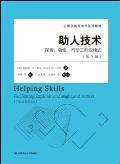本书将介绍一个构筑在实践、理论和实证研究基础上的整合的助人模式。立足于实践和理论是非常重要的,这意味着此模式是从那些成就卓著的临床心理学家和理论心理学家的理论中发展而来的,是以他们卓越的工作成果为基础的。罗杰斯、弗洛伊德(Freud)、埃里克森(Erikson)、马勒(Mahler)、斯金纳(Skinner)、艾利斯(Ellis)、贝克(Beck)以及其他一些临床心理学家已经对人类的本质、心理咨询和心理治疗中改变发生的机制,以及协助个体发挥潜能、实现目标的技术有了深入的洞见。而我将要介绍的这个包括三个阶段的助人模式正是基于这些睿智的理论家的贡献,读者们可以借此模式来了解他们的理论精髓。
使咨询模式建立在实证研究的基础上,也很重要。实证研究可以帮助助人者了解如何运用助人技术是有效的,如何是无效的。我们之所以对这些技术的运用有很强的信心,是因为这些技术经过实证研究确认是有效的。当然,助人技术的研究才刚刚起步,还存在着很多未知领域。因此,我希望通过提供一个清晰的助人过程模式,吸引更多愿意做实证研究的人来检验它[关于实证的基础,请参阅本书的姊妹篇(Hill,2001)]。
此模式包括三个阶段:探索阶段、领悟阶段、行动阶段。探索阶段以当事人中心理论为基础(例如,Rogers,1942,1951,1957,1959);领悟阶段以精神分析理论和人际理论(例如,Freud,1940/1949;Teyber,2006;Yalom,1980)为基础;行动阶段的理论则来自行为治疗理论(例如,Goldfried & Davison,1994;Kazdin,2001;Watson & Tharp, 2006)。之所以把这些主要理论整合在此三阶段模式中,是因为有实际证据表明它们是有效的(参见Wampold, 2001)。
助人过程可看作一个不断变化的互动事件序列(Hill,1992)。一般来说,对于如何帮助当事人,助人者会逐渐形成一套自己的设想。助人者的设想来源于他们对当事人状况的了解以及他们与当事人共同商定的在特定时限内要达成的目标。设想一旦形成,助人者则开始运用言语和非言语的技术对当事人进行干预。同时,当事人以自己的方式来回应助人者施予的干预。当事人的个人特点决定了他们会用什么样的行为与助人者互动。如此来说,助人过程不仅涉及外显的行为,也涉及助人者与当事人的认知过程(比如助人者的设想和当事人的反应)。意识到自己的助人设想和意图,有助于助人者选择有效的干预措施,而留意当事人对干预措施的反应,能帮助助人者设计后续的干预。
Interview With Clara E. Hill About Helping Skills: Facilitating Exploration, Insight, and Action, Third Edition
In this video author Clara E. Hill talks about her book, Helping Skills: Facilitating Exploration, Insight, and Action, Third Edition. (5 minutes, 21 seconds)
Transcript
Interviewer [female voice]: Your book, Helping Skills, is now in its third edition and has become a bestseller among books for trainee psychotherapists and other skilled helpers. Do you have any thoughts as to why it enjoys continued success?
Clara Hill: Well, I'm glad it does. What I've been told is that it's relatively easy to understand, it's pretty clearly written. But it also doesn't talk down to people. So, I think a problem with a lot of the other books in the field is either they get way too complicated and make therapy seem like it's too difficult to understand, or it's too simplistic. And so some of the authors really speak down to people and make it feel like they're not very smart.
And so I think — because I've taught Helping Skills for over four years now, and I really try to pay attention to my trainees and what levels they're at and take their feedback very seriously — I've been able to kind of aim it at an audience that can get it and can understand it.
Interviewer: Could you briefly explain your three-stage model of helping?
Clara Hill: Yes. The three stages are exploration, insight, and action. The idea is that exploration — the client needs to explore deeply and think deeply about their thoughts and feelings about an issue. And then once they've thought deeply about it, it kind of naturally moves in to insight, where they understand things at a deeper level. Sometimes with the therapist having to move back and give them alternate perspectives and challenge them, and work with the therapeutic relationship. And then once they understand themselves at a deep level, what we want to help people do is move to action, to try to figure out how they can change what they do. So it's important that you not just understand but that you move on to making changes in life.
Interviewer: How has your model evolved over time since you first began using it?
Clara Hill: I think the main thing is that at first it was relatively rigid. At first it was kind of like you do reflections of feelings, and then you do interpretations, and then you do action or interactional skills. And as I become more comfortable, I think, with myself and as a therapist, what I've realized is that things don't work that simply but that you need to be more flexible and more adaptive to doing what works at a given time.
So, what I think now is more we teach therapists these different skills, we help them learn when to use them and how to use them. And then once they kind of master the skills, then they go out and do what works for them. So it's not as much an automatic kind of thing as, "Here are some skills. Let's focus on you for a while." And then once you go out, try to work with a client, then you try to figure out what works with that particular client.
Interviewer: What are the most common challenges students struggle with in learning to become professional helpers?
Clara Hill: The biggest challenge is moving from a friendship role to a professional role. And by that I mean in a friendship role, we talk 50/50. In a professional role, the therapist often talks 15, 20 percent of the time. That's really difficult to shift. In a friendship role, we give lots of advice, we self-disclose. And those aren't things we do typically in a therapy relationship.
So, it's really difficult at the beginning for a therapist to shift that role. And then later, the more advanced skills are more difficult in terms of learning when to challenge, when to use immediacy, when to do interpretation. But that beginning thing is really making that major shift from a friendship to a professional role.
Interviewer: To what extent is becoming a skilled helper an innate gift or talent, and to what extent is it learned?
Clara Hill: Both. Certain people have more empathy than others. And people have — by the time they come in to wanting to be trained as a therapist — they've been interacting with people for all their lives. So, there are certain people who have more interactional skills, more emotional intelligence, more ability to be empathic. And those are the people we tend to take into training, both by our selection and by themselves selecting themselves.
And then we can shape them a little bit. We can get them to use more of some skills and less of some other ones. We can help them not interrupt as much, to not self-disclose as much but to use more reflections of feelings. But it really is an interaction between the two, such that we take talented people who are emotionally intelligent and then help them become more aware of their behaviors and figure out what effect they're having on clients.
And one of the things we always talk about is helping people look at their reaction to clients. Not that there are specific skills that are the right ones, but for a particular client, there are things that they could do that could help.

